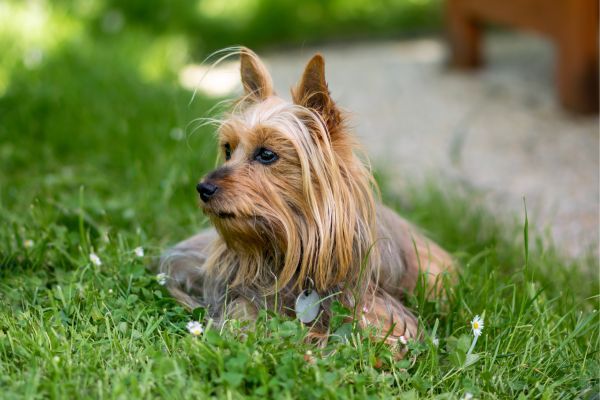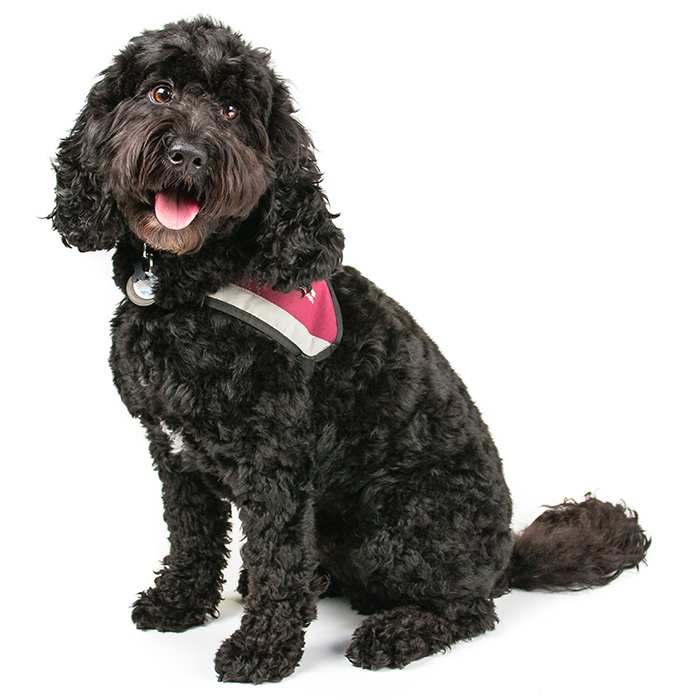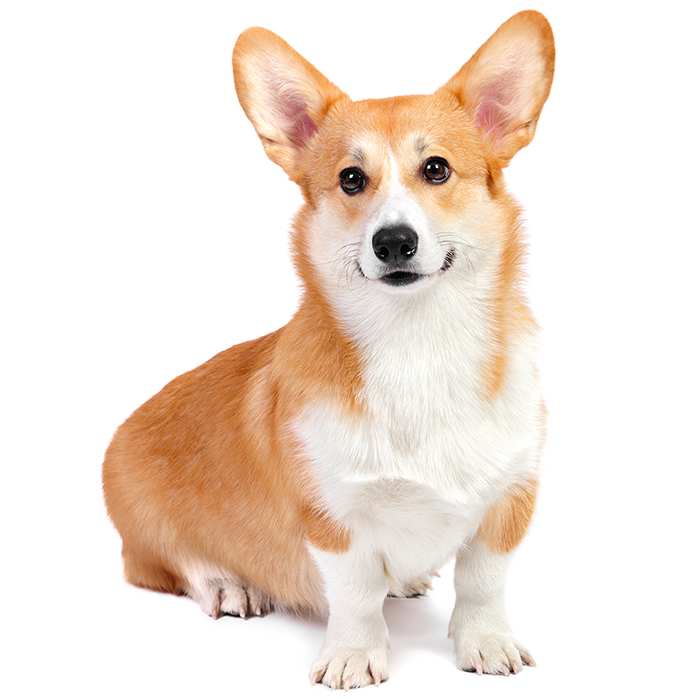Silky Terrier
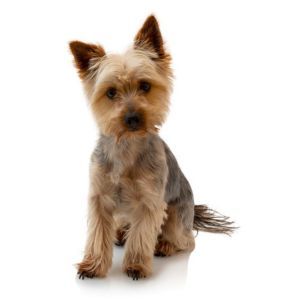

| Recommended for | Families and individuals with active lifestyles; suitable for small living spaces |
| Breed Classification | Toy Group |
| Other names | Australian Silky Terrier, Silky |
| Lifespan | 12 – 15 years |
| Size | Small |
| Temperament | Responsive, inquisitive, friendly, alert, quick, joyful |
| Intelligence | High |
| Tendency to bark | High, particularly when greeting strangers |
| Maintenance Level | High grooming needs, low food costs |
| Health Risk | This breed is in the lower risk category for developing health issues, hence it is one of the least expensive breeds to insure |
Insuring a Silky Terrier?
Get our award-winning Nose-to-Tail Cover with up to $30k annual benefit limit, up to 90% of eligible vet bills back, and no sub-limits.
Get a quick quote
Is this breed right for you?
Try our breed selector quiz to find out your best matching breed!
Insuring a Silky Terrier?
Get our award-winning Nose-to-Tail Cover with up to $30k annual benefit limit, up to 90% of eligible vet bills back, and no sub-limits.
Get a quick quote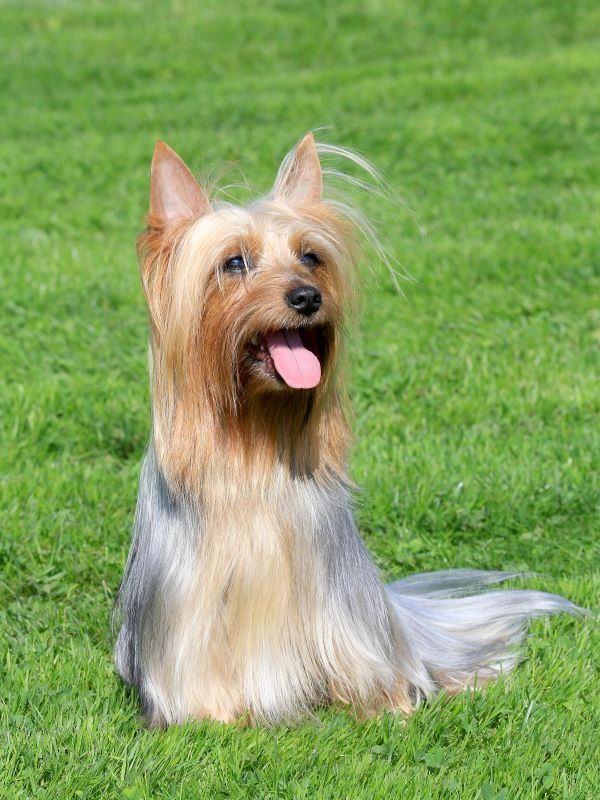
Breed history of Silky Terriers
While all agree that the Silky Terrier was “made in Australia”, it’s origins are not all that clear. British migrants to Australia at the end of the 18th century brought with them a selection of early British Terrier types, some of which are now extinct. These dogs had to be small in size because of space and food restrictions on the sailing ships of the period.
The early settlers needed a dog to control rodents and snakes and also watch animal stock on their properties, requiring it to be quick to chase and bring down anything that scurried or slithered. This led to much haphazard cross-breeding that eventually produced the Australian Terrier. This new terrier came in two distinct groups, one with a coarse, wiry coat and the other with a soft textured coat, with successive breeding programs strengthened the characteristics of each group. At some stage the Yorkshire Terrier was introduced into the breeding program, initially to develop the blue and tan colour and then later to improve the texture and length of the soft coated Australian Terrier.
A structured breeding program continued to further refine and develop the breed, and the first breed standard was drawn up by the Victorian Silky Terrier Club. However, Sydney breeders decided to have their own standard and the breed was known there as the Sydney Silky.
In 1934, the Kennel Control Council (KCC) introduced special regulations which essentially prohibited cross breeding between the Silky, Yorkshire and Australian terriers. As a consequence, the breed quickly stabilised. After consultation with all Australian states, the KCC officially recognised the breed as the Australian Silky Terrier in the June 1956 edition of the KCC Gazette. In 1959, a committee of Kennel Club representatives from NSW and Victoria met and breeders finally agreed on a national standard.
The Silky Terrier was introduced in the United States by American soldiers returning from World War II and became fashionable after it appeared in the media in 1954. Today the breed remains a popular household companion in Australia and around the world. Despite being a true terrier at heart, the Silky is categorised in the Toy group.
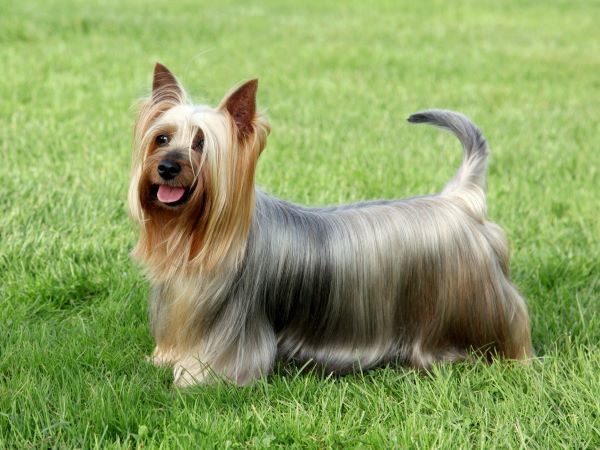
Physical description of Silky Terriers
The Silky Terrier has a small, compact, well-proportioned build. It has a wedge-shaped head, expressive, dark, almond-shaped eyes, erect V-shaped ears and a straight, delicate muzzle. The Silky carries itself with an air of alertness and confidence, just like any “true terrier”.
The stand-out feature of the Silky is its long, straight, silky coat which is mainly in blue and tan in colour, and feels and behaves much like human hair. The coat is parted down the middle, and profuse enough on the head to form a top-knot. Colour variations include be silver-blue and fawn.
The casual observer can be forgiven for mistaking a Silky for a Yorkshire or Australian Terrier at first glance. For the record, Silkys are larger than Yorkies and smaller than Aussies.
| Weight range | 3.5 – 4.5 kg |
| Height range | 23 – 25 cm |
| Colours | Predominantly blue and tan, with variations including silver-blue or fawn top-knots and dark blue roots |
| Coat length | Long |
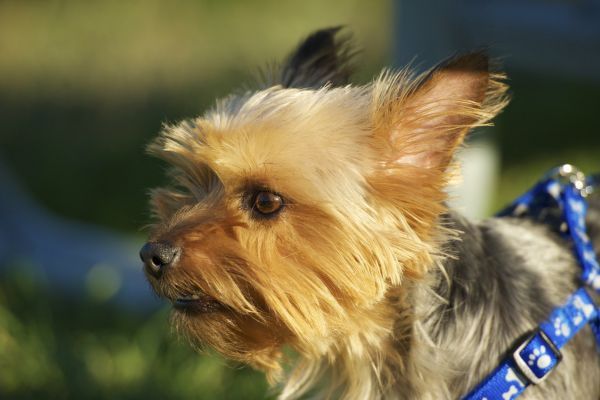
Silky Terrier personality and temperament
The Silky Terrier is a true terrier – brave, spirited and adventurous with bold personality and playful demeanour. Despite their small size, they possess a tough and confident attitude, and are often oblivious to their small stature. With a natural inclination for hunting vermin, Silkys thrive on activity and challenge, which can be satisfied through games and interactive play in the home or yard.
Known for their sociability, Silky Terriers make loving family companions, although they usually form a stronger bond with one person. While they are generally friendly toward strangers, they are attentive and vocal watchdogs, alerting their owners to anything unusual, though their tendency to bark can occasionally be excessive.
Silky Terriers are highly intelligent and rank among the top small breeds for their ability to learn quickly, but they also have a mischievous side and can display a defiant streak. Despite their independence, Silkys are deeply loyal and affectionate toward their families. They thrive in close contact with their owners and enjoy participating in daily activities.
Highly adaptable, they are equally suited to suburban family life and apartment living as well as to various lifestyles, but they do best with owners who provide consistent engagement and mental stimulation.

Silky Terriers with kids and other pets
Silky Terriers are affectionate and lively companions, well-suited for families with growing children. Their playful and energetic nature makes them delightful playmates for older, considerate kids who know how to handle small dogs gently. While they are generally loving and patient, their small size and spirited temperament mean that supervision is essential, especially around younger children, to ensure safe and positive interactions.
With other pets, Silky Terriers can adapt well if socialised early, though their bold terrier instincts may sometimes lead to assertive behaviour. They typically get along with other dogs but may require careful introductions and consistent monitoring to ensure harmony. Their natural ratter instinct means they are always watching for scurrying prey, which makes interactions with smaller animals, such as rabbits or rodents, more challenging.
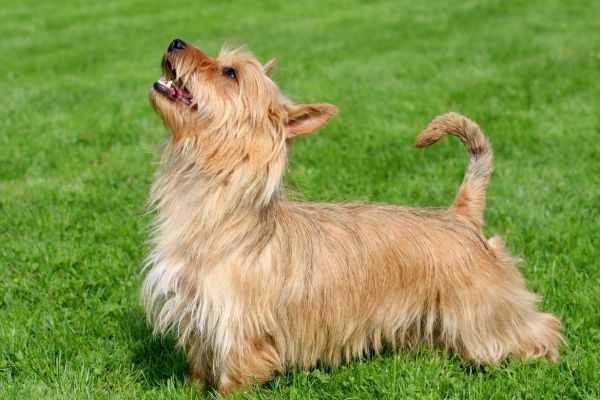
Silky Terrier training and exercise
Though small in size, Silky Terriers possess high energy levels and need daily exercise to maintain their physical and mental well-being. Regular walks, interactive play, and activities like puzzle toys or teaching new tricks are essential to keep them engaged and prevent boredom. They thrive on close family contact, enjoying involvement in daily routines, which strengthens their bond with their owners. Silkys excel in activities such as agility or obedience training, which provide mental stimulation and channel their energy productively, leveraging their
Silky Terriers are highly intelligent and responsive, with a natural eagerness to learn, making them relatively easy to train using positive reinforcement techniques. Their stubborn streak, however, can be challenging and requires patience and consistency from their owners. To succeed, training must be engaging and fun, as these independent thinkers are unlikely to respond well to repetitive or uninteresting tasks. Early socialisation and consistent training are vital for shaping well-mannered behaviour and preventing undesirable habits.
| Energy level | High |
| Exercise requirements | Medium |
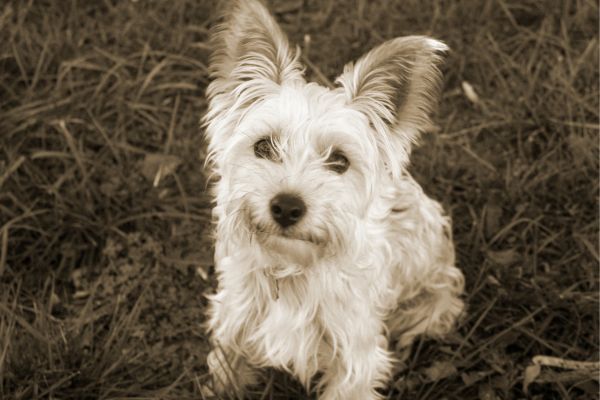
Silky Terrier feeding and nutrition
Silky Terriers require a well-balanced diet tailored to their small size and energy levels. High-quality dog food, whether commercial or home-prepared, should provide essential nutrients to maintain their health and vitality. Due to their small stomachs, portion control is crucial to avoid overfeeding, with small, frequent meals being ideal. Puppies need protein-rich diets to support growth, while adults require balanced nutrition to sustain energy, and seniors may benefit from lower-calorie options and joint supplements. Fresh water should always be available to keep them hydrated.
Monitoring calorie intake and adjusting portions based on activity level are key to preventing obesity in this active breed. Treats should be given sparingly, with attention and affection serving as healthier rewards. Regular veterinary consultations ensure the diet meets your dog’s changing needs throughout its life stages, promoting optimal health and well-being.
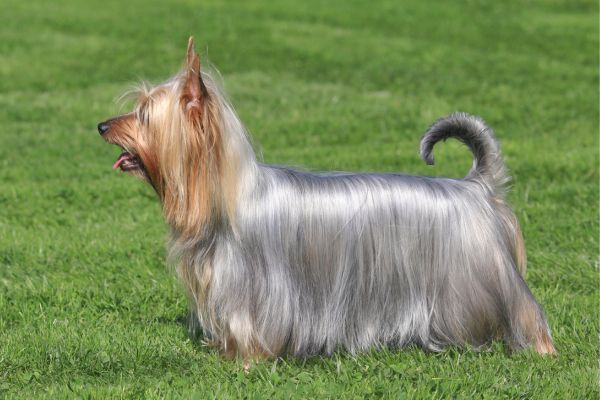
Silky Terrier care and grooming
The Silky Terrier’s coat is a defining feature, with its long, fine, and glossy texture requiring regular grooming to maintain its sleek appearance and prevent tangles. Daily brushing is ideal to keep the coat smooth and free from mats, especially since their silky hair can easily become knotted if left unattended. Notes that tangles and mats are uncomfortable for your dog and can cause skin problems to develop. Regular grooming also helps remove loose hairs and distribute natural oils for a healthy, shiny coat.
Trimming and clipping are necessary to maintain the coat’s length and neatness, particularly around the feet, ears, and underbelly, where hair tends to grow longer. While Silky Terriers do not shed excessively, routine baths, along with nail trimming and dental care, are important to keep them clean and healthy. Proper care not only enhances their appearance but also contributes to their overall comfort and well-being.
Health issues for Silky Terriers
- Cataracts cause a cloudy lens in the eye, leading to varying degrees of vision loss. While smaller cataracts may require an ophthalmoscope for detection, larger cataracts are easily visible and significantly impair eyesight. This hereditary condition can be managed with surgery to restore vision in affected dogs.
- Progressive Retinal Atrophy (PRA) is a genetic disorder that results in the gradual degeneration of the retina, leading to blindness. Symptoms, including night blindness and dilated pupils, typically appear between 3–9 years of age. While there is no cure, dogs with PRA can still lead fulfilling lives with proper care and accommodations.
- Dental Disease is a common issue in Silky Terriers due to tartar buildup, leading to bad breath, tooth loss, and difficulty eating. Without regular at-home dental care and professional cleanings, the condition can worsen, causing discomfort and health issues. Veterinary dental exams every 6–12 months are recommended for prevention.
- Liver Shunts occur when a blood vessel bypasses the liver, impairing its function. Symptoms include stunted growth, seizures, and coordination issues. Diagnosis requires imaging or exploratory surgery, and treatment often involves a combination of medication and surgery.
- Patellar Luxation involves the dislocation of the kneecap due to a shallow groove in the femur. Severity varies, with mild cases being manageable and severe cases requiring surgery. Breeders should screen dogs for this condition to reduce its prevalence.
- Legg-Calve-Perthes Disease is a hip condition caused by insufficient blood supply to the femur, resulting in bone degeneration. This painful disorder is most common in puppies and requires surgical intervention for treatment.
- Malassezia Dermatitis is a yeast-related skin condition causing itchiness, blackened or greasy skin, and a strong odour. Treatment includes topical therapies, anti-itch medications, and, in severe cases, oral anti-fungal drugs to alleviate symptoms.
Not all conditions are covered by Pet Insurance. For details of Bow Wow Meow Pet Insurance cover, refer to the Product Disclosure Statement.
Free engraved pet ID tag on sign up3
Customer Satisfaction
21 day cooling off
Easy to use Pet Portal

GapOnly® in vet claims
MORE INFORMATION
Australian Silky Terrier Club of Victoria Inc: https://www.australiansilkyterrierclub.org.au/
Silky Terrier Club of America: https://silkyterrier.net/
Silky Terrier Club of America, Inc.: http://silkyterrierclubofamerica.org/

